Today the newest real rate bond SGBi3108 will be tapped in a regular auction, the first one this year.
The relatively low demand in combination with a relatively strong SEK presents a new situation. How will this impact consumer prices? We see risk of low inflation in 2012.
The Riksbank’s Company Survey published yesterday supports our outlook for
benign price pressure in Sweden.
The BEI curve has steepened quite a lot lately. Some more steepening might occur but we see more potential in BEI tightener at the front, selling SGBi3105 vs. SGB1049.
First auction this year
Since the last auction and Index-Linked Report from 23 November, the real rate curve has flattened whereas the BEI curve has steepened. For instance, the BEI box 3105/3108 has steepened by 20bp. We have argued for some time now that the BEI curve should steepen, but we are probably approaching a point where it is time to take profit. Forward BEI rates at the longer end of the curve are much higher today than a few months ago. The forward rates have moved 40-50bp since late November, so in order for the BEI curve to steepen more it will probably require tighter BEI rates along the whole curve. Otherwise forward BEI rates will be too elevated.
So we see room for lower forward BEI rates and positioning for such a move might be possible in the auction, buying the SGBi3108 and selling the longest SGBi3104. However, we expect this to primarily be a result of tighter BEI rates along the curve, so a much simpler way is to sell linkers against nominals in BEI spreads. This looks particularly interesting given the recent rise in shorter nominal bond yields. It is attractive to alter the BEI steepener (SGBi3105/SGBi3108) into an “outright” BEI tightener in the short dated spread, selling SGBi3105 against SGB1049. Next week will bring both the outcome of the Riksbank’s policy meeting and January CPI (16 February). 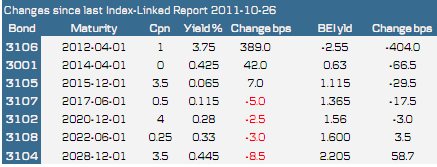
The Riksbank's Company Survey supports our stance
Yesterday the Riksbank’s Company Survey was released which supports our stance that Swedish inflation will be subdued this year. For instance, the following can be read:
“The decline in economic activity and the concern about the future have had a significant impact on the companies’ pricing plans…. A compilation of the companies’ responses indicates that price increases will be well under two per cent looking one year ahead.”
Moreover, it is interesting to note that there has been a huge swing in how the companies assess how demand will influence price setting going forward. It is clear that the demand situation is holding prices down. In fact, a majority of companies said that the decline in demand is squeezing prices, according to the survey. 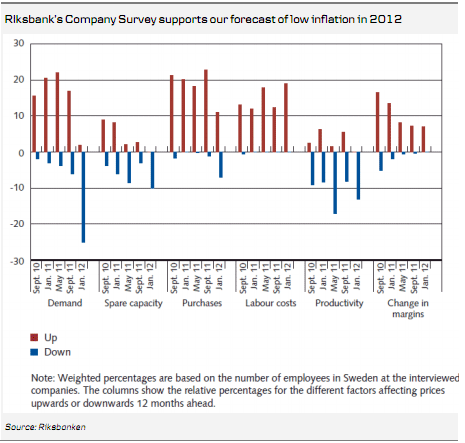
Apart from the slack in demand stemming from low growth, another factor plays an important role in the slowdown in retail demand the past year. In the years 2009-2010 the strong retail sales/private consumption was, at least partly, driven by some home equity extractions. In 2011 the growth of new loans decelerated and we see no reason to why it should pick up again this year. Admittedly, a lower policy rate will probably bolster lending to households somewhat, but the introduction of a 85% cap on LTV and the banking sector being in a kind of deleveraging mode (not leveraging at least) will hinder such an development. Housing prices are slowly declining as well as lending to households. Our forecast for private consumption (goods) is +1% in 2012, which should be compared to “boom year” 2010 when it was +4.5%. We do not foresee a collapse in private consumption (this happened in 2011), more like a sideways move from a relatively low starting point. It is not a very upbeat forecast but pretty strong given that we fear the unemployment rate will start to rise this year. In all, it will however, weigh on the companies’ pricing power. 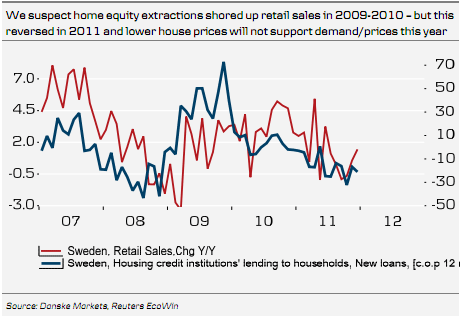
Relatively low demand and relatively strong SEK - a new combination
So the companies are experiencing relatively low demand from consumers, which squeezes prices, and this happens amid a relatively strong SEK. Normally when growth (demand) slows, the Swedish krona depreciates (see chart below), but this time the krona, at least so far, has remained relatively stable. Especially against EUR. This might put even more pressure on consumer prices going forward, compared to other times with a slack in demand, in the sense that imported goods will not become much more expensive, which otherwise makes retailers reluctant to cut or hold prices. 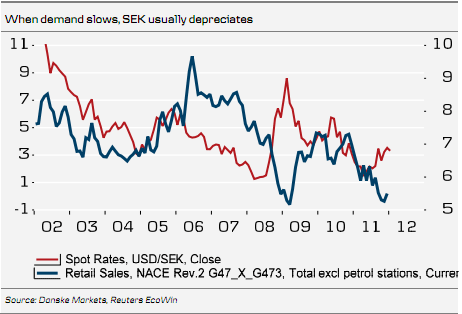
The new situation with relatively low consumer demand together with a relatively strong currency might also hold shorter BEI rates in check – as inflation falls. So, despite the recent steepening of the BEI curve, our macro outlook indicates there is room for more steepening ahead. The retail sales data have historically been related to how the BEI curve trades, see chart below, but short term it might have difficulties performing since the long-dated forward BEI rates are at relatively high readings after a rise of about 40-50bp in the last couple of months. Instead, we see room for a general decline in BEIs. After a recent rise in short nominal bond yields we argue that it might be a good opportunity to scrap the longer spread in the BEI curve box but to remain short in the SGBi3105 against the nominal counterpart, SGB1049. 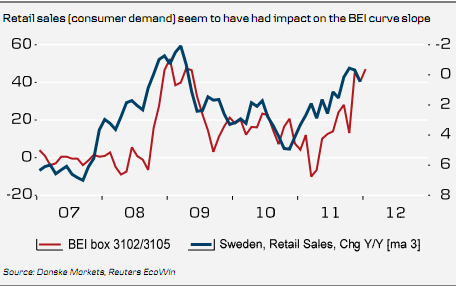
The short BEI rate, 3105, trades at a too elevated level given our inflation outlook and how we see the macro environment unfolding during this year. The bond also trades too expensive in the BEI rate when compared to how the German 2016 BEI rates trade. The BEI box, which normally trades in line with the relative inflation data, will clearly turn even more negative if our forecasts materialize, see chart. We see it as likely that the box, currently at -20bp, moves closer to -50bp. 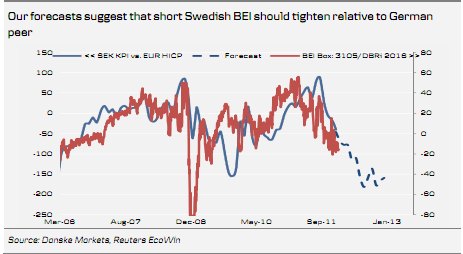
We prefer longer linkers - investors in search for inflation protection should buy SGBi3108 in the auction
We see more value in the longer real rates since we expect Swedish inflation to be very subdued during 2012. This will probably weigh on short-dated linkers, especially in BEI terms. The sell-off in shorter nominal bonds offers a good opportunity to shift from a BEI curve steepener into an outright BEI tightener at the front end of the curve. Sell SGi3105 in the BEI spread against SGB0149. 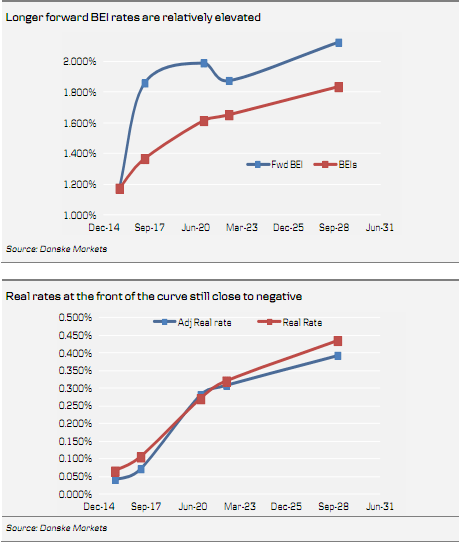
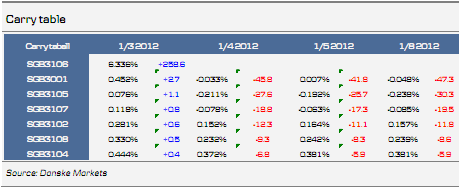
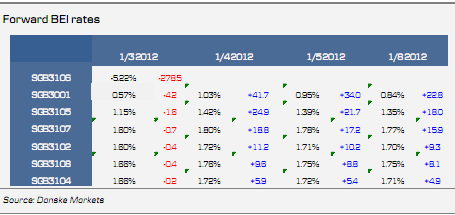
- English (UK)
- English (India)
- English (Canada)
- English (Australia)
- English (South Africa)
- English (Philippines)
- English (Nigeria)
- Deutsch
- Español (España)
- Español (México)
- Français
- Italiano
- Nederlands
- Português (Portugal)
- Polski
- Português (Brasil)
- Русский
- Türkçe
- العربية
- Ελληνικά
- Svenska
- Suomi
- עברית
- 日本語
- 한국어
- 简体中文
- 繁體中文
- Bahasa Indonesia
- Bahasa Melayu
- ไทย
- Tiếng Việt
- हिंदी
First Swedish Auction of the Year on Tap
Published 02/09/2012, 08:06 AM
Updated 05/14/2017, 06:45 AM
First Swedish Auction of the Year on Tap
Latest comments
Loading next article…
Install Our App
Risk Disclosure: Trading in financial instruments and/or cryptocurrencies involves high risks including the risk of losing some, or all, of your investment amount, and may not be suitable for all investors. Prices of cryptocurrencies are extremely volatile and may be affected by external factors such as financial, regulatory or political events. Trading on margin increases the financial risks.
Before deciding to trade in financial instrument or cryptocurrencies you should be fully informed of the risks and costs associated with trading the financial markets, carefully consider your investment objectives, level of experience, and risk appetite, and seek professional advice where needed.
Fusion Media would like to remind you that the data contained in this website is not necessarily real-time nor accurate. The data and prices on the website are not necessarily provided by any market or exchange, but may be provided by market makers, and so prices may not be accurate and may differ from the actual price at any given market, meaning prices are indicative and not appropriate for trading purposes. Fusion Media and any provider of the data contained in this website will not accept liability for any loss or damage as a result of your trading, or your reliance on the information contained within this website.
It is prohibited to use, store, reproduce, display, modify, transmit or distribute the data contained in this website without the explicit prior written permission of Fusion Media and/or the data provider. All intellectual property rights are reserved by the providers and/or the exchange providing the data contained in this website.
Fusion Media may be compensated by the advertisers that appear on the website, based on your interaction with the advertisements or advertisers.
Before deciding to trade in financial instrument or cryptocurrencies you should be fully informed of the risks and costs associated with trading the financial markets, carefully consider your investment objectives, level of experience, and risk appetite, and seek professional advice where needed.
Fusion Media would like to remind you that the data contained in this website is not necessarily real-time nor accurate. The data and prices on the website are not necessarily provided by any market or exchange, but may be provided by market makers, and so prices may not be accurate and may differ from the actual price at any given market, meaning prices are indicative and not appropriate for trading purposes. Fusion Media and any provider of the data contained in this website will not accept liability for any loss or damage as a result of your trading, or your reliance on the information contained within this website.
It is prohibited to use, store, reproduce, display, modify, transmit or distribute the data contained in this website without the explicit prior written permission of Fusion Media and/or the data provider. All intellectual property rights are reserved by the providers and/or the exchange providing the data contained in this website.
Fusion Media may be compensated by the advertisers that appear on the website, based on your interaction with the advertisements or advertisers.
© 2007-2025 - Fusion Media Limited. All Rights Reserved.
